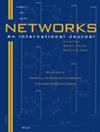资源约束的聚类最短路径树问题:数学公式和Branch&Price求解算法
IF 1.3
4区 计算机科学
Q4 COMPUTER SCIENCE, HARDWARE & ARCHITECTURE
引用次数: 1
摘要
本文定义了资源约束的簇状最短路径树问题。它推广了经典的资源约束最短路径树问题,因为它是在一个无向、完全和加权图上定义的,该图的节点集被划分为簇。然后,目标是找到一个最短路径树,该树遵循一些资源消耗约束,并在每个簇中诱导一个连通子图。研究这一问题的主要支持和动机与电信网络的设计和灾害行动管理等有关。在这项工作中,我们提出了一个基于路径的问题公式,解决了局部资源约束的情况,即单路径上的资源约束。为了解决这一问题,设计了一种具有多重定价方案的列生成方法的Branch&Price算法。进行了全面的计算研究,将所提出的方法与用于求解数学模型的CPLEX求解器所获得的结果进行了比较。数值结果表明,Branch&Price算法在求解成本和时间方面都优于CPLEX算法。本文章由计算机程序翻译,如有差异,请以英文原文为准。
The resource constrained clustered shortest path tree problem: Mathematical formulation and Branch&Price solution algorithm
In this article, the Resource Constrained Clustered Shortest Path Tree Problem is defined. It generalizes the classic Resource Constrained Shortest Path Tree Problem since it is defined on an undirected, complete and weighted graph whose set of nodes is partitioned into clusters. The aim is then to find a shortest path tree respecting some resource consumption constraints and inducing a connected subgraph within each cluster. The main support and motivation for studying this problem are related, among the others, to the design of telecommunication networks, and to Disaster Operations Management. In this work, we present a path‐based formulation for the problem, addressing the case of local resource constraints, that is, resource constraints on single paths. For its resolution, a Branch&Price algorithm featuring a Column Generation approach with Multiple Pricing Scheme is devised. A comprehensive computational study is conducted, comparing the proposed method with the results achieved by the CPLEX solver, adopted to solve the mathematical model. The numerical results underline that the Branch&Price algorithm outperforms CPLEX, both in terms of solution cost and time.
求助全文
通过发布文献求助,成功后即可免费获取论文全文。
去求助
来源期刊

Networks
工程技术-计算机:硬件
CiteScore
4.40
自引率
9.50%
发文量
46
审稿时长
12 months
期刊介绍:
Network problems are pervasive in our modern technological society, as witnessed by our reliance on physical networks that provide power, communication, and transportation. As well, a number of processes can be modeled using logical networks, as in the scheduling of interdependent tasks, the dating of archaeological artifacts, or the compilation of subroutines comprising a large computer program. Networks provide a common framework for posing and studying problems that often have wider applicability than their originating context.
The goal of this journal is to provide a central forum for the distribution of timely information about network problems, their design and mathematical analysis, as well as efficient algorithms for carrying out optimization on networks. The nonstandard modeling of diverse processes using networks and network concepts is also of interest. Consequently, the disciplines that are useful in studying networks are varied, including applied mathematics, operations research, computer science, discrete mathematics, and economics.
Networks publishes material on the analytic modeling of problems using networks, the mathematical analysis of network problems, the design of computationally efficient network algorithms, and innovative case studies of successful network applications. We do not typically publish works that fall in the realm of pure graph theory (without significant algorithmic and modeling contributions) or papers that deal with engineering aspects of network design. Since the audience for this journal is then necessarily broad, articles that impact multiple application areas or that creatively use new or existing methodologies are especially appropriate. We seek to publish original, well-written research papers that make a substantive contribution to the knowledge base. In addition, tutorial and survey articles are welcomed. All manuscripts are carefully refereed.
 求助内容:
求助内容: 应助结果提醒方式:
应助结果提醒方式:


